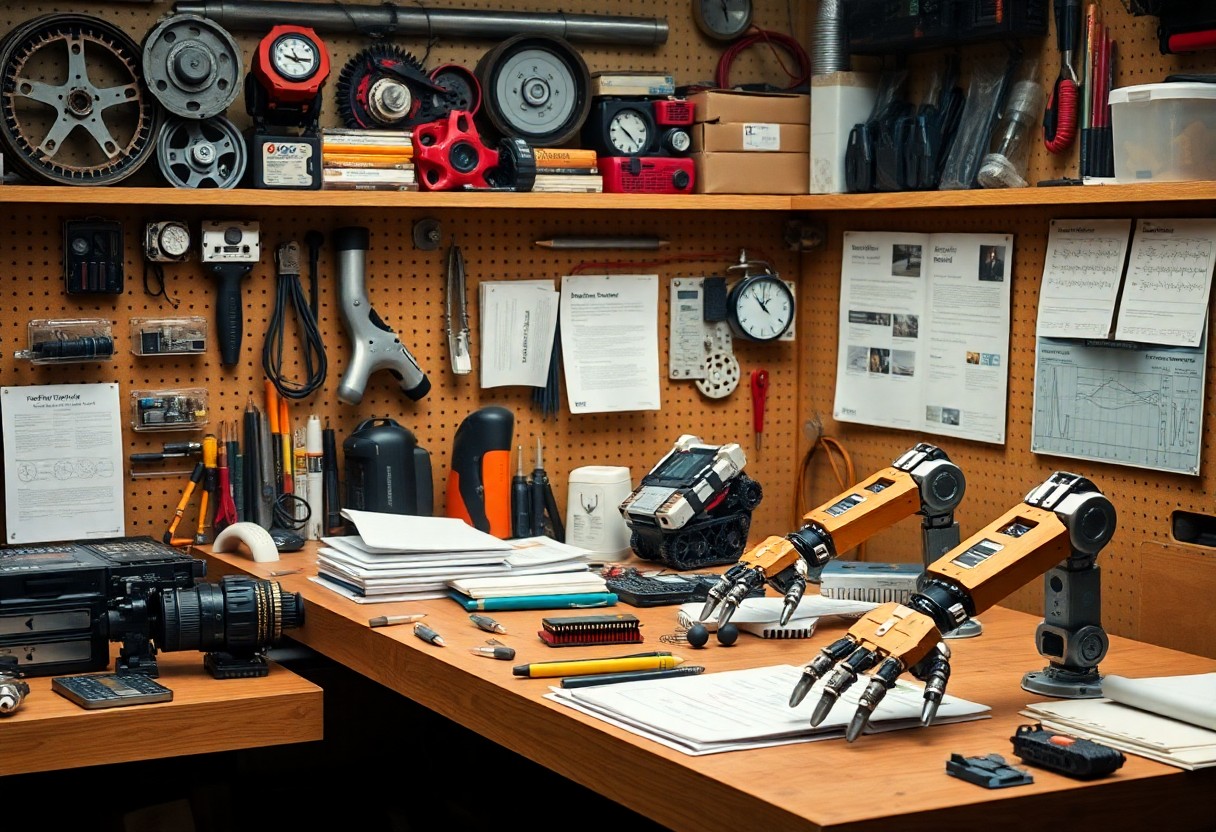Many aspiring roboticists seek to enhance their skills, yet understanding the intricate mechanisms behind successful robot design is vital. By exploring advanced components such as sensors, actuators, and control systems, you can transform your robotic projects into functional masterpieces. This blog post will guide you through the various mechanisms that can refine your approach and elevate your capabilities, enabling you to tackle complex challenges with confidence. Dive in to discover how these elements can not only improve your designs but also boost your overall understanding of robotics.
Understanding Basic Robotics Concepts
While delving into robotics, it’s crucial to grasp foundational concepts that serve as the backbone of this exciting field. Understanding these principles not only enhances your design capabilities but also equips you to tackle advanced projects more effectively. From dynamics to control systems, acquiring a strong foundation in basic robotics concepts will significantly elevate your robot-building skills.
Fundamental Components of Robots
Behind every successful robot lies a combination of crucial components, which include sensors, actuators, and a control system. Sensors collect data from the environment, while actuators bring movement and life to your creations. Understanding these building blocks is vital for creating well-functioning robots that can perform tasks and interact with their surroundings.
Key Programming Languages for Robotics
Among the programming languages that you can utilize in robotics, Python, C++, and ROS (Robot Operating System) stand out for their effectiveness and versatility. Each language has its strengths, making it beneficial to choose based on your project’s specific requirements and your programming proficiency.
Programming plays an integral role in robotics, as it dictates how your robot reacts and performs tasks. Python offers simplicity and ease of use, ideal for beginners, while C++ provides the speed and efficiency necessary for real-time systems. ROS facilitates the use of multiple programming languages and integrates various tools, making it a popular choice in professional robotics. By familiarizing yourself with these languages, you’ll empower your robots with the intelligence needed to navigate complex environments and execute tasks with precision.
Advanced Design Techniques
If you aim to enhance your robot-building skills, consider implementing advanced design techniques that can streamline your process and boost functionality. These techniques can significantly impact your workflow and the performance of your robotics projects:
- Utilize 3D modeling for precision.
- Incorporate simulations to test designs.
- Adopt modular design principles for versatility.
- Use iterative prototyping to refine your ideas.
- Experiment with advanced materials for durability.
| Technique | Description |
|---|---|
| 3D Modeling | Create accurate models to visualize components. |
| Simulations | Test design efficacy virtually before building. |
| Modular Design | Build using interchangeable parts for easy upgrades. |
Utilizing CAD Software for Prototyping
To effectively prototype your robotic components, leveraging CAD (Computer-Aided Design) software can be invaluable. This technology allows you to create detailed 3D models, test various configurations, and analyze component interactions, all of which prepare you for successful production and assembly.
Integrating Sensors and Actuators
Against common misconceptions, integrating sensors and actuators into your robotic designs is simpler than it appears. These components play a vital role in enabling your robot to interact with its environment and perform autonomous actions, turning theoretical models into dynamic, responsive machines.
Understanding the significance of sensors and actuators is key to elevating your robotics projects. Sensors provide crucial environmental feedback, allowing your robot to perceive its surroundings. Actuators, on the other hand, bring movement and action to your designs. By effectively integrating these elements, you enhance the capabilities and functionality of your robots, resulting in smarter and more adaptable creations.
Building a Strong Foundation in Electronics
Now that you’ve begun your journey into robotics, establishing a solid base in electronics is crucial for your success. This knowledge empowers you to understand how various components interact, control systems effectively, and troubleshoot problems that may arise. By immersing yourself in the fundamentals, you can create more complex and functional robots, laying the groundwork for your advanced projects.
Essential Circuit Design Skills
Building your circuit design skills is vital in your robotic endeavors. Understanding how to create and modify schematic diagrams will allow you to visualize your electronic projects better. Start with simple circuits, and gradually incorporate various components such as resistors, capacitors, and sensors. This hands-on approach will deepen your understanding and enhance your confidence in designing effective circuits.
Understanding Microcontrollers
Any aspiring robotics enthusiast must grasp the workings of microcontrollers. These compact computing units act as the brain of your robot, processing inputs and executing commands based on your programming. Familiarizing yourself with their architecture, programming languages, and interfacing methods will enable you to harness their full potential in your projects.
Indeed, mastering microcontrollers opens up a world of possibilities for your robotic creations. By learning specific programming languages like Arduino or Raspberry Pi, you can efficiently control various components, including motors and sensors. Experimenting with different microcontroller models will give you insights into performance and capabilities, enhancing your ability to select the right one for each project. Understanding their nuances not only empowers you to craft responsive robots but also equips you with problem-solving skills that are crucial in the field of electronics.
Enhancing Programming Skills
Despite the complexity associated with robot programming, honing your skills in this area is vital for your success. Mastering programming languages such as Python or C++ will allow you to effectively communicate with your robot’s software and hardware components. Additionally, engaging in hands-on projects can solidify your understanding, ensuring that you are equipped to tackle more advanced challenges as they arise.
Learning Algorithm Development
At the core of robotics lies algorithm development, where you learn to devise solutions that enable your robot to perform tasks efficiently. Familiarizing yourself with concepts like pathfinding, motion planning, and sensor integration will sharpen your problem-solving abilities. By experimenting with various algorithms, such as genetic algorithms or neural networks, you can better understand how different approaches affect your robot’s performance.
Exploring Robotics Frameworks
A diverse array of robotics frameworks, such as ROS (Robot Operating System), exists to support you in building more sophisticated systems. By utilizing these frameworks, you can take advantage of pre-built libraries and tools that simplify your development process. As you explore these platforms, you’ll discover how they facilitate communication between different components of your robot, enhancing the overall functionality and efficiency of your projects.
A comprehensive understanding of robotics frameworks is important for streamlining your development process and expanding your capabilities. Familiarizing yourself with the features of ROS, for instance, allows you to leverage community-driven resources and tutorials to accelerate your learning. Additionally, exploring alternatives like V-REP or Gazebo can provide unique insights and options for simulation, enabling you to test and iterate on your designs without the need for physical hardware. Embracing these frameworks not only enhances your programming skills but also prepares you for collaboration with other developers and engineers in the dynamic field of robotics.
Practical Application and Prototyping
After exploring into theoretical concepts, it’s vital to translate your knowledge into practical experience. Engaging in prototyping will enhance your skills and understanding of robot mechanics. For insights on streamlined processes, check out Advanced Robotics Demystified in 4 Steps – ISTE, which provides a clear framework to advance your robot-building journey.
Steps to Create Your First Robot
To launch on your robot-building adventure, start by defining a simple project that aligns with your interests. Gather necessary materials and tools before designing your robot’s functionality and layout. Once the design is set, begin assembling components while keeping documentation of each step for future reference.
Iteration and Testing Techniques
Above all, effective iteration and rigorous testing are key to refining your robot. As you build, consistently evaluate your progress by testing different functionalities, making adjustments as needed to enhance performance.
Robot development is an iterative process where success comes from making modifications based on testing outcomes. You should analyze each test result critically to identify areas for improvement. Adopting a loop of build, test, and refine not only enhances your design but also deepens your understanding of engineering principles, ultimately leading to more innovative and efficient robot creations.
Community Engagement and Resources
Many aspiring robot builders underestimate the value of community engagement and available resources in enhancing their skills. By connecting with fellow enthusiasts, you can exchange knowledge, encounter diverse perspectives, and find encouragement in overcoming challenges. Participating in local meetups or online platforms can broaden your understanding and expose you to new ideas and techniques, ultimately elevating your robot-building expertise.
Joining Robotics Clubs and Online Forums
Below, you’ll find that joining robotics clubs and online forums allows you to network with like-minded individuals. These spaces offer opportunities for collaboration, sharing projects, and asking questions. Being part of a community helps you stay updated on the latest trends and access resources that might otherwise be hard to find.
Utilizing Online Tutorials and Courses
Below, you are encouraged to utilize online tutorials and courses that can supplement your hands-on experience in robot-building. These resources often cater to different skill levels, providing you with the foundational knowledge and advanced techniques needed to excel.
Online tutorials and courses are an invaluable asset in your journey. Many platforms offer structured lessons on topics ranging from robot design to programming languages, ensuring you can find quality content that fits your learning style. By following guided tutorials, you can gain practical experience, troubleshoot common challenges, and explore innovative approaches to robotics. Whether you prefer video lectures, interactive content, or reading materials, there’s a plethora of options to help you deepen your understanding and refine your skills.
Conclusion
Now you have a clearer understanding of the intricate mechanisms that can significantly elevate your robot-building skills. By focusing on system integration, mastering programming, and embracing prototyping methodologies, you can enhance both your technical capabilities and creative problem-solving. Engaging with robotics communities and experimenting with diverse tools will equip you with the knowledge and confidence you need to innovate. Keep challenging yourself, and soon you will see remarkable advancements in your robotics projects.







